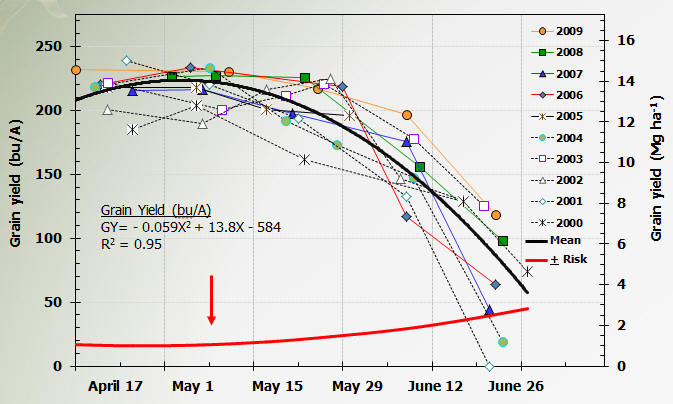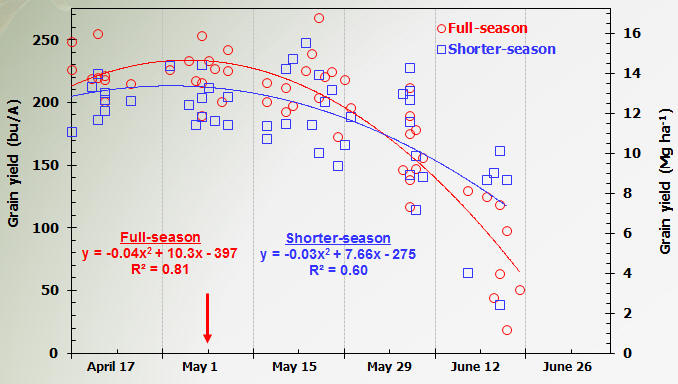| May 12, 2011 |
Field Crops 28.42 - 83 |
| |
|
Corn Hybrid Relative Maturity Switch Dates for 2011
Joe Lauer, Corn Agronomist
With the cool wet spring we have had so far in 2011, planting corn in northeast
Wisconsin has been delayed. In general, if all corn in Wisconsin could be planted
on one day, that optimum date would be May 1 in the south and May 7 in the north.
Once corn planting is delayed beyond these optimum dates then grain yield decreases
AND grain moisture increases in most years. By May 15 corn yield is decreasing 0.5
bu/A per day delay accelerating to 2.5 bu/A per day delay on June 1 (Figure 1).

Figure 1. The planting date producing maximum corn grain yield is May 1. Grain
yield decreases 0.5 bu/A per day on May 15 and accelerates to 2.5 bu/A per day on
June 1. Source: Lauer (Full-season hybrid at Arlington, WI).
For corn to develop and progress from planting to emergence normally takes about
125 Growing Degree units (GDUs). During the first week in May, southern Wisconsin
normally accumulates about 10 GDUs per day, so emergence takes about 12.5 days.
This year in an experiment conducted at the UW Agricultural Research Station - Arlington
the earliest planting date treatment was April 13. This treatment experienced snow
and minimum air temperatures in the low 20s F. As of May 12, none of the three hybrids
planted in this experiment had begun to emerge yet. So there really has not been
enough GDUs for much emergence to take place yet for much of the early planting
season. The recent warm weather should help with plant emergence.
There is an yield and moisture trade-off between full- and shorter-season
relative maturity (RM) hybrids. In southern Wisconsin the yield trade-off is 1.9
bushels per RM unit. For example, a 100 d ay RM would typically yield 19 bu/A more
than a 90 day RM hybrid. The highest yielding hybrids are those that utilize entire
growing season and are typically full-season for maturity. Eventually full-season
hybrids run out of growing season and are impacted more for grain yield than shorter-season
hybrids (Figure 2). Relative maturity must be balanced against harvest grain moisture
and the ensuing drying costs required to dry grain down to 15.5% moisture. Full-season
hybrids are often wetter than shorter-season hybrids at grain harvest.

Figure 2. Shorter-season hybrids (7 to 10 days RM) become more economical (yield
and moisture) than full-season hybrids after about May 23. Source: Lauer (Arlington,
WI, 2002-2010).
This year, especially in northeast Wisconsin, many farmers are concerned about the
need to switch hybrids from full- to shorter-season relative maturity. Switch date
is influenced by corn price and fuel price for drying costs. As corn price
increases, the switch date of hybrids from full- to shorter-season occurs later.
As drying cost increases, the switch date of hybrids from full-
to shorter-season relative maturity occurs earlier. Typically the switch date for
corn ranges between May 20-25. When farmers switch to new hybrids they should shorten
relative maturity of hybrids to be planted by 7-10 days.
The switch date decision is also influenced by the eventual use of the corn (Table
1). If the field to be planted is intended for corn silage or high moisture grain,
then switch dates can be later because there is less concern about drying costs.
The crop needs to achieve between 25% kernel milk for silage and black layer for
high moisture corn grain yield to optimize yield.
Table 1. Relative maturity of adapted corn hybrids for different planting dates
and relative maturity zones in Wisconsin.
|
|
|
Relative maturities for late planting on
|
Full-season relative maturity zone
(planting before May 15)
|
May 20
|
June 1
|
June 10
|
June 20
|
|
|
|
|
|
|
|
80 and earlier
|
75- 80
|
75- 80 (silage)
|
--
|
--
|
|
85- 90
|
80- 85
|
75- 80 (silage)
|
--
|
--
|
|
90- 95
|
85- 90
|
75- 80
|
75- 80 (silage)
|
--
|
|
95-100
|
90- 95
|
80- 85
|
75- 80 (silage)
|
--
|
|
100-105
|
95-100
|
85- 90
|
75- 80
|
75- 80 (silage)
|
|
105-110
|
100-105
|
90- 95
|
80- 85
|
75- 80 (silage)
|
|
110-115
|
105-110
|
95-100
|
85- 90
|
75- 80 (silage)
|
Another factor influencing switch date is, what shorter-season hybrids do you
switch to? During the winter, a lot of research often goes into selecting
good high performing full-season hybrids. But as the decision to switch to shorter-season
hybrids draws near, do you have enough time to adequately research and find a good
performing shorter-season hybrid? Is a good high-performing hybrid available
from the seed company? Remember the basics (see
http://corn.agronomy.wisc.edu/AA/A082.aspx) as you select new hybrids
and don't be pressured into switching into just any hybrid - make sure it is a good
performer.
In addition, switch dates are influenced by geographical location.
There is more flexibility for southern Wisconsin than northern Wisconsin. In southern
Wisconsin, we have two or more possible switch dates for grain, May 20-25 and June
1-5 (Table 1). While in northern Wisconsin, we have only one switch date May 20-25.
If corn planting is delayed until June 1 in northern Wisconsin and June 15 in southern
Wisconsin, then growers should consider putting corn planters away and planting
soybean. The low corn yields seen in June will not recover the input costs required
to produce the crop. This decision is influenced by corn price, price of the alternative
crop (usually soybean) and the proportion of farm acres of each crop left to be
planted. If the production objective is dry grain and you have been delayed, then
you may want to begin pricing fuel for fall drying.
Corn planters could be brought back out after July 1. By this time, if
fields are not planted, the production objective becomes "emergency
forage" for dry matter production. We have produced up to 6.8 T/A dry
matter with July planting dates for corn (see
http://corn.agronomy.wisc.edu/Research/03DOP/Late2005.pdf and
http://corn.agronomy.wisc.edu/Research/03DOP/Late2006.pdf). We are not
to this point yet.
One last point is that late-planted corn often has increased pest pressure, especially
from European corn borer (ECB). Planting a transgenic Bt-CB hybrid can help manage
ECB if pressure is high.
Corn Replanting or Late-Planting Decisions (UWEX
Bulletin A3353) for guidelines on switch dates for corn hybrid maturity.